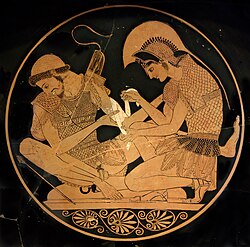
Back Trojaanse Oorlog Afrikaans Trojanischer Krieg ALS Guerra de Troya AN حصار طروادة Arabic حرب طرواده ARZ Guerra de Troya AST Troya müharibəsi Azerbaijani تروی ساواشی AZB Троя һуғышы Bashkir Траянская вайна Byelorussian
| Trojan War |
|---|
 |
| Part of a series on |
| Greek mythology |
|---|
 |
| Deities |
| Heroes and heroism |
| Related |
|
|
The Trojan War was a legendary conflict in Greek mythology that took place around the 12th or 13th century BC. The war was waged by the Achaeans (Greeks) against the city of Troy after Paris of Troy took Helen from her husband Menelaus, king of Sparta. The war is one of the most important events in Greek mythology, and it has been narrated through many works of Greek literature, most notably Homer's Iliad. The core of the Iliad (Books II – XXIII) describes a period of four days and two nights in the tenth year of the decade-long siege of Troy; the Odyssey describes the journey home of Odysseus, one of the war's heroes. Other parts of the war are described in a cycle of epic poems, which have survived through fragments. Episodes from the war provided material for Greek tragedy and other works of Greek literature, and for Roman poets including Virgil and Ovid.
The ancient Greeks believed that Troy was located near the Dardanelles and that the Trojan War was a historical event of the 13th or 12th century BC. By the mid-19th century AD, both the war and the city were widely seen as non-historical, but in 1868, the German archaeologist Heinrich Schliemann met Frank Calvert, who convinced Schliemann that Troy was at what is now Hisarlık in modern-day Turkey.[1] On the basis of excavations conducted by Schliemann and others, this claim is now accepted by most scholars.[2][3]
The historicity of the Trojan War remains an open question. Many scholars believe that there is a historical core to the tale, though this may simply mean that the Homeric stories are a fusion of various tales of sieges and expeditions by Mycenaean Greeks during the Bronze Age. Those who believe that the stories of the Trojan War are derived from a specific historical conflict usually date it to the 12th or 11th century BC, often preferring the dates given by Eratosthenes, 1194–1184 BC, which roughly correspond to archaeological evidence of a catastrophic burning of Troy VII,[4] and the Late Bronze Age collapse.
- ^ Bryce, Trevor (2005). The Trojans and their neighbours. Taylor & Francis. p. 37. ISBN 978-0-415-34959-8.
- ^ Rutter, Jeremy B. "Troy VII and the Historicity of the Trojan War". Archived from the original on 9 January 2023. Retrieved 31 January 2022.
- ^ In the second edition of his In Search of the Trojan War, Michael Wood notes developments that were made in the intervening ten years since his first edition was published. Scholarly skepticism about Schliemann's identification has been dispelled by the more recent archaeological discoveries, linguistic research, and translations of clay-tablet records of contemporaneous diplomacy. Wood, Michael (1998). "Preface". In Search of the Trojan War (2 ed.). Berkeley, CA: University of California Press. p. 4. ISBN 0-520-21599-0.
Now, more than ever, in the 125 years since Schliemann put his spade into Hisarlik, there appears to be a historical basis to the tale of Troy
- ^ Wood (1985: 116–118)